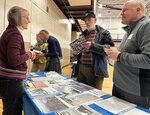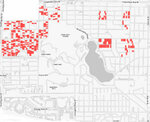By Aamira Redd
Como residents are dismantling racial covenants and preserving untold stories through Know Your Como, a transformative neighborhood history project.
Thomas Frankson, a prominent figure in the early 20th century, left a lasting impact on the Como neighborhood as a real estate developer and politician. Frankson, who served as Lieutenant Governor of Minnesota from 1917 to 1921, played a pivotal role in enacting some of the earliest racial covenants, effectively prohibiting people of color from purchasing property in Como.
In an effort to acknowledge the impact of racial covenants, Como’s Neighborhood Relations Committee proposed the idea of creating an informational piece near the Frankson Mansion.
“If we can come together to have a historic marker, some sort of signage, or artwork that tells the story and memorializes the actions we took to raise awareness then we can become more thoughtful about our neighborhood’s past and future,” said Laura Oyen, who is a part of the District 10 Community Council and has also worked closely with the Como History Project.
While the effort to get a commemorative piece acknowledging racial covenants is still underway, the project has evolved into something much greater. Know Your Como, as it is known, has gained the involvement of a dedicated group of neighborhood volunteers who are passionate about discovering more about Como’s past.
These individuals have taken on the role of historians, archivists, and storytellers, working to document the personal narratives and cherished mementos that have been shared by long-time residents. Documenting these stories are another way for neighbors to connect over similar life experiences.
“[Como residents] may have gone to the same schools or went to the same church, so they have a lot of the same experiences, but even within those pieces that are the same, I’m really amazed at the unique remembrances that are very unique to each individual person,” said Oyen.
RECOGNIZING RACIAL COVENANTS
Like many other neighborhoods in the United States, Como was once subject to racial covenants that limited the ability of people of color to own property in the area.
Racial covenants were legally binding agreements that prohibited property owners from selling or renting their properties to people of certain races or ethnicities.
In June of 2022, St. Catherine’s University and Mapping Prejudice launched the “Welcoming Dear Neighbor?” project that aimed to uncover the discriminatory housing practices in Ramsey County. According to research conducted by Mapping Prejudice, around 350 racist deeds were found in Como.
As part of the Neighborhood History Project’s comprehensive approach, Dr. Rachel Neiwert, a professor at St. Catherine’s University, and her students embarked on a journey to uncover the intricate ways in which historical housing discrimination continues to perpetuate inequality in Ramsey County.
Their research, conducted in collaboration with the project, delved into newspapers and digitized archives, unearthing stories that highlight the struggles for housing equity and the presence of racism.
One story that Neiwert often tells is that of Nellie Francis, an African-American woman who was an activist and suffragist in the early 1900s. Francis along with her husband, William T. Francis, lived in the Mac-Groveland area, which like Como, had racially covenants.
Francis and her husband were subjected to violence and harassment by White neighbors who were determined to keep their neighborhood Whites-only. While the Francis’ fought hard to stay in their home by reaching out to law enforcement and politicians, they eventually left after William was offered a job in Liberia.
For Neiwert, she believes retelling these stories is a way to have deeper conversations about racial injustice and inequities in our communities.
“I do think White people need me to show up and say, ‘I have learned these things, so let’s learn together and see how it helps us effectively talk about what’s happening in our community,’” said Neiwert. “Because if they could stop imagining that the homeownership gap is just a natural thing, it is not a natural thing. Our world is structured by racism.”
Although racial covenants officially became illegal in 1968, the racist and discriminatory language used in these racial covenants can still be found today. For this reason, many neighbors have taken the initiative to remove these deeds from their homes.
“The impetus for the history project was to gain a deeper understanding going beyond just the pretty history of the park and looking a little bit more at the complexity of these neighborhoods, who lived here, and how the neighborhoods grew and changed over time,” said Como resident Lija Greenseid.
The project holds significant importance, particularly considering the impact of the murder of George Floyd, which sparked a nationwide conversation about systemic racism.
“I think the racial covenants ties in with this history project because in both cases it links back to the murder of George Floyd and the aftermath of which touched really close to our homes here,” said Greenseid.
THE FUTURE OF THE NEIGHBORHOOD HISTORY PROJECT
This summer, Know Your Como is broadening its reach by exploring stories from other neighborhoods. The goal is to get perspectives from folks who have spent time in different areas of Como to see how their experiences compare to others.
“We want to caution against saying that everyone in Como had the same memory, because we’ve only scratched half the surface,” said Oyen.
As the story of Como’s history continues to unfold, the ongoing project is constantly evolving to capture the essence of this ever-growing community. A significant aspect of this evolution is the goal to gather more present-day, contemporary stories from the residents themselves.
“We are approaching [Know Your Como] from two different ends of the spectrum, trying to think of it over time as: if you were to interview someone today, what would their experiences be living in the Como neighborhood in 2023? Those will be the historic stories of tomorrow,” said Oyen.





Comments
No comments on this item Please log in to comment by clicking here